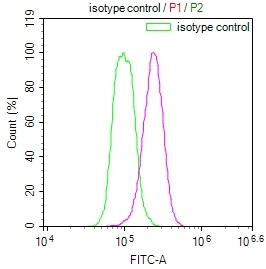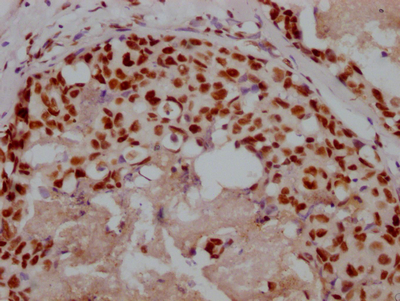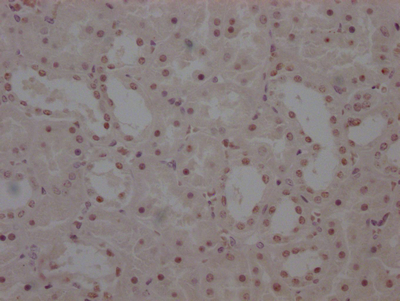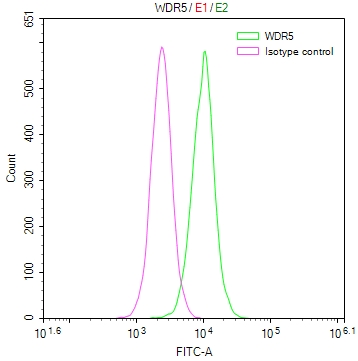HCFC1 Antibody, FITC conjugated
-
中文名稱:HCFC1兔多克隆抗體, FITC偶聯
-
貨號:CSB-PA010166LC01HU
-
規格:¥880
-
其他:
產品詳情
-
產品名稱:Rabbit anti-Homo sapiens (Human) HCFC1 Polyclonal antibody
-
Uniprot No.:
-
基因名:HCFC1
-
別名:C1 factor antibody; CFF antibody; HCF 1 antibody; HCF antibody; HCF C-terminal chain 6 antibody; HCF-1 antibody; HCF1 antibody; Hcfc1 antibody; HCFC1_HUMAN antibody; HFC1 antibody; Host cell factor 1 antibody; Host cell factor antibody; Host cell factor C1 (VP16 accessory protein) antibody; Host cell factor C1 antibody; MGC70925 antibody; MRX3 antibody; VCAF antibody; VP16 accessory protein antibody
-
宿主:Rabbit
-
反應種屬:Human
-
免疫原:Recombinant Human Host cell factor 1 protein (201-428AA)
-
免疫原種屬:Homo sapiens (Human)
-
標記方式:FITC
-
克隆類型:Polyclonal
-
抗體亞型:IgG
-
純化方式:>95%, Protein G purified
-
濃度:It differs from different batches. Please contact us to confirm it.
-
保存緩沖液:Preservative: 0.03% Proclin 300
Constituents: 50% Glycerol, 0.01M PBS, PH 7.4 -
產品提供形式:Liquid
-
儲存條件:Upon receipt, store at -20°C or -80°C. Avoid repeated freeze.
-
貨期:Basically, we can dispatch the products out in 1-3 working days after receiving your orders. Delivery time maybe differs from different purchasing way or location, please kindly consult your local distributors for specific delivery time.
-
用途:For Research Use Only. Not for use in diagnostic or therapeutic procedures.
相關產品
靶點詳情
-
功能:Involved in control of the cell cycle. Also antagonizes transactivation by ZBTB17 and GABP2; represses ZBTB17 activation of the p15(INK4b) promoter and inhibits its ability to recruit p300. Coactivator for EGR2 and GABP2. Tethers the chromatin modifying Set1/Ash2 histone H3 'Lys-4' methyltransferase (H3K4me) and Sin3 histone deacetylase (HDAC) complexes (involved in the activation and repression of transcription, respectively) together. Component of a THAP1/THAP3-HCFC1-OGT complex that is required for the regulation of the transcriptional activity of RRM1. As part of the NSL complex it may be involved in acetylation of nucleosomal histone H4 on several lysine residues. Recruits KMT2E/MLL5 to E2F1 responsive promoters promoting transcriptional activation and thereby facilitates G1 to S phase transition.; (Microbial infection) In case of human herpes simplex virus (HSV) infection, HCFC1 forms a multiprotein-DNA complex with the viral transactivator protein VP16 and POU2F1 thereby enabling the transcription of the viral immediate early genes.
-
基因功能參考文獻:
- Data show that Myc boxes (MbIV) is required for the association of MYC with the abundant transcriptional coregulator host cell factor-1 (HCF-1). PMID: 26522729
- The M4 motif (ACTAYRNNNCCCR) is a functional regulatory bipartite cis-element, which engages a THAP11/HCF-1 complex via binding to the ACTAYR module, while the CCCRRNRNRC subsequence part constitutes a binding platform for Ikaros and NFKB1 PMID: 27576892
- Beyond its well-known role in adding beta-O-GlcNAc to serine and threonine residues of nuclear and cytoplasmic proteins, OGT also acts as a protease in the maturation of the cell cycle regulator, HCF-1, and serves as an integral member of several protein complexes, many of them linked to gene expression. (Review) PMID: 27294441
- findings show that cellular factors OCT2 and HCF1 bind OriP in association with Epstein-Barr virus nuclear antigen 1 to maintain elevated histone H3K4me3 and transcriptional enhancer function PMID: 27009953
- O-GlcNAcylation of the transcription regulators Host Cell Factor-1 (HCF-1) and Ten-Eleven Translocation protein 2 (TET2) could be readily observed. Our study raises questions on the occurrence and abundance of O-GlcNAcylation as a histone modification PMID: 26075789
- These results demonstrate that distinct OGT-binding sites in HCF-1 promote proteolysis, and provide novel insights into the mechanism of this unusual protease activity. PMID: 26305326
- our work identifies plausible cellular consequences of missense HCFC1 variants and identifies likely and relevant disease mechanisms that converge on embryonic stages of brain development. PMID: 25740848
- We report here two brothers with dysmorphic features and complex malformations resulting from an X-linked inherited cobalamin deficiency due to HCFC1 gene mutation. PMID: 25595573
- THAP11, ZNF143, and HCF-1 form a mutually dependent complex on chromatin, which is independent of E2F occupancy. PMID: 25437553
- study reports the tetratricopeptide-repeat domain of O-GlcNAc transferase binds the carboxyl-terminal portion of an HCF-1 proteolytic repeat such that the cleavage region lies in the glycosyltransferase active site above uridine diphosphate-GlcNAc; protein glycosylation and HCF-1 cleavage occur in the same active site PMID: 24311690
- A missense mutation in a global transcriptional coregulator, HCFC1, was identified as the genetic basis of an X-linked form of combined methylmalonic acidemia and hyperhomocysteinemia. PMID: 24011988
- HCFC1 is a common component of active human CpG-island promoters and coincides with ZNF143, THAP11, YY1, and GABP transcription factor occupancy. PMID: 23539139
- MLL5 can associate with HCF-1 and then be recruited to E2F1-responsive promoters to stimulate H3K4 trimethylation and transcriptional activation. PMID: 23629655
- A noncoding, regulatory mutation was identified in the binding site of transcription factor YY1 in the HCFC1 gene in patients with nonsyndromic intellectual disability. PMID: 23000143
- Host cell factor C1 recruits O-GlcNAc transferase to O-GlcNAcylate PGC-1alpha, and O-GlcNAcylation facilitates the binding of the deubiquitinase BAP1, thus protecting PGC-1alpha from degradation and promoting gluconeogenesis. PMID: 22883232
- HCF-1(N)-HCF-1(C) association via an integrated Fn3 structure permits an NLS to facilitate formation of a transcriptional regulatory complex PMID: 23045687
- THAP11 was found to associate physically with the transcriptional coregulator HCF-1 (host cell factor 1) and recruit HCF-1 to target promoters PMID: 22371484
- Studies suggest that BAP1 influences cell proliferation at G1/S by co-regulating transcription from HCF-1/E2F-governed promoters. PMID: 21484256
- These results reveal an unexpected role of OGT in HCF-1 proteolytic maturation and an unforeseen nexus between OGT-directed O-GlcNAcylation and proteolytic maturation in HCF-1 cell-cycle regulation. PMID: 21295698
- HCF-1 interacts with the middle region of YY1 encompassing the glycine-lysine-rich domain and is essential for the formation of a ternary complex with YY1 and BAP1 in vivo. PMID: 20805357
- Data show that the HCF-1 Basic region displays striking structural flexibility for controlling cell proliferation. PMID: 20126307
- THAP1 mediates the recruitment of HCF-1 to the RRM1 promoter during endothelial cell proliferation and that HCF-1 is essential for transcriptional activation of RRM1. PMID: 20200153
- NSL is composed of nine subunits. Two of its subunits, WD repeat domain 5 (WDR5) and host cell factor 1 (HCF1), are shared with members of the MLL/SET family of histone H3 lysine 4 (H3K4) methyltransferase complexes. PMID: 20018852
- Data show that Asf1b localizes with HCF-1 in viral replication foci and depletion of Asf1b results in significantly reduced viral DNA accumulation. PMID: 20133788
- HCF-1 activity is regulated by HPIP by modulating its subcellular localization PMID: 12235138
- HCF-1 contains an activation domain (HCF-1(AD)) required for maximal transactivation by VP16 and its cellular counterpart LZIP. PMID: 12271126
- The results presented in this paper suggest that HCF-1 can broadly regulate transcription, both positively and negatively, through selective modulation of chromatin structure. PMID: 12670868
- These results suggest that host cell factor-1 (HCF-1) links the regulation of exit from mitosis and the G(1) phase of cell growth, possibly to coordinate the reactivation of gene expression after mitosis. PMID: 12743030
- Three proteins found to contain the HCF-binding motif were further analyzed for their ability to use HCF-1 as a coactivator. Krox20 and E2F4 showed a strong requirement for HCF-1 to activate activation transcription, while estrogen receptor-alpha did not. PMID: 14532282
- The fibronectin domain of HCF interacts with HCF in the herpes simplex virus VP16-induced transcriptional activating complex, an association requiring a region outside the putative HCF beta-propeller fold PMID: 16042417
- HCF-1 was required for recruitment of the histone methyltransferases Set1 and MLL1, leading to histone H3K4 trimethylation and transcriptional activation. PMID: 17578910
- During the G1-to-S phase transition, HCF-1 recruits the mixed-lineage leukemia (MLL) and Set-1 histone H3 lysine 4 methyltransferases to E2F-responsive promoters and induces histone methylation and transcriptional activation. PMID: 17612494
- The results are consistent with a pathway whereby PRC regulates NRF-2-dependent genes through a multiprotein complex involving HCF-1. PMID: 18343819
- A viable hypothesis for disease development is presented based on the known interaction between HCFC1 and the herpes simplex viral protein VP16 PMID: 18520591
- The identified components revealed factors involved in histone methylation and cell cycle control and include Ash2L, RbBP5, WDR5, HCF-1, DBC-1, and EMSY. PMID: 19131338
- The most interesting biological findings were the binding sites for SREBP-1 in genes for host cell factor C1 (HCFC1), involved in cell cycle regulation PMID: 19292868
- Sequence changes in the E2F1 HCF-1-binding site can modulate both up and down the ability of E2F1 to induce apoptosis indicating that HCF-1 association with E2F1 is a regulator of E2F1-induced apoptosis. PMID: 19763085
- BAP1 regulates cell proliferation by deubiquitinating HCF-1 PMID: 19815555
顯示更多
收起更多
-
相關疾?。?/div>Mental retardation, X-linked 3 (MRX3)亞細胞定位:Cytoplasm. Nucleus.組織特異性:Highly expressed in fetal tissues and the adult kidney. Present in all tissues tested.數據庫鏈接:
Most popular with customers
-
-
YWHAB Recombinant Monoclonal Antibody
Applications: ELISA, WB, IHC, IF, FC
Species Reactivity: Human, Mouse, Rat
-
-
-
-
-
-



















